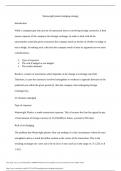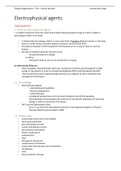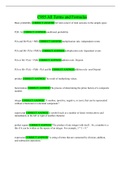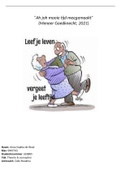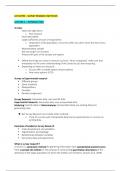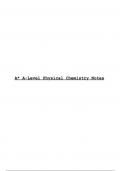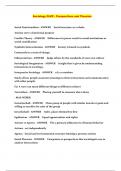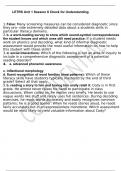Unit 5 – Cost Behaviour and Classification
Defining Cost
Cost can be defined as the amount of resources, usually in monetary terms, that is sacrificed
in order to achieve a particular objective.
Historic Cost – the price paid for the item
Replacement Cost – the price that would need to be paid to buy the item now, in its current
condition
Realisable Value – the price the business could sell the item for now
Opportunity Cost – the amount forgone by not taking the next best opportunity
Value in Use – the value of continuing to use an asset
Relevant Costs to Making a Decision
Future opportunity costs and future outlay costs need to:
Relate to the business’ objectives, it needs to affect its wealth
Be a future cost
Wary with a decision
Sunk Costs and Committed Costs
A sunk cast, also called a past cost, are costs that have already been incurred and cannot be
recovered, whilst a committed cost has not yet been spent yet. Although, there is an
agreement to spend it and cannot be changed, its equal to sunk cost.
As these costs cannot be changed by any future decisions they aren’t relevant to making
decisions.
Product and Period Costs
Product costs are costs that are incurred in the production of a product, these may include
labour, raw materials and factory overhead.
Period costs are costs, treated as expenses, in the period in which they are incurred, they
are all the costs that aren’t included in the product cost. They aren’t directly related to the
production process
Direct Costs and Indirect Costs
Direct Costs are prices that can be directly tied to the production of specific goods or
services, they are often variable costs as they can fluctuate with production levels
Indirect Costs are costs that are associated with maintenance and running of a business.
They are spread over a number of identifiable units of the business, for example: products,
services, or departments wherein costs are determined. Also known as overhead costs
, Variable and Fixed Costs
Variable Costs are costs that directly change with fluctuations in production over a certain
period of time, they can increase or decrease depending on the level of production or sales
volume, these can include materials or packaging
Output (number of 100 200 300
phones)
Total Cost (£s) 1,000 2,000 3,000
The cost increases by £10 for every phone produced meaning that variable cost = £10 per
unit
Fixed Costs these are costs that aren’t directly changed due to changes in a business’
production levels over a certain period of time, such as rent.
Output (number of 100 200 300
phones)
Total Cost (£s) 3,000 3,000 3,000
As total cost remains at £3,000, as production increases unit cost decreases due to the fact
the fixed cost is being spread over more units. £30 per unit, £15 per unit, £10 per unit
Semi-Variable Costs these are costs that have both a fixed and variable element to them,
such as phone bills with a fixed monthly rent plus a variable cost charge for calls.
Output (number of 100 200 300
phones)
Total Cost (£s) 2,100 2,200 2,300
Fixed cost of £2,000 + a variable cost of £10 per unit
600
500 Stepped Costs are fixed costs that
Total cost in £s
400 increase by steps, that aren’t
300 directly proportional to increasing
200 levels of production, they are
100 constant at certain levels of activity
and only change when certain
0 thresholds are met
0 100 200 300
And Example of this would be rent
Activity in units storage space when it reaches full
Defining Cost
Cost can be defined as the amount of resources, usually in monetary terms, that is sacrificed
in order to achieve a particular objective.
Historic Cost – the price paid for the item
Replacement Cost – the price that would need to be paid to buy the item now, in its current
condition
Realisable Value – the price the business could sell the item for now
Opportunity Cost – the amount forgone by not taking the next best opportunity
Value in Use – the value of continuing to use an asset
Relevant Costs to Making a Decision
Future opportunity costs and future outlay costs need to:
Relate to the business’ objectives, it needs to affect its wealth
Be a future cost
Wary with a decision
Sunk Costs and Committed Costs
A sunk cast, also called a past cost, are costs that have already been incurred and cannot be
recovered, whilst a committed cost has not yet been spent yet. Although, there is an
agreement to spend it and cannot be changed, its equal to sunk cost.
As these costs cannot be changed by any future decisions they aren’t relevant to making
decisions.
Product and Period Costs
Product costs are costs that are incurred in the production of a product, these may include
labour, raw materials and factory overhead.
Period costs are costs, treated as expenses, in the period in which they are incurred, they
are all the costs that aren’t included in the product cost. They aren’t directly related to the
production process
Direct Costs and Indirect Costs
Direct Costs are prices that can be directly tied to the production of specific goods or
services, they are often variable costs as they can fluctuate with production levels
Indirect Costs are costs that are associated with maintenance and running of a business.
They are spread over a number of identifiable units of the business, for example: products,
services, or departments wherein costs are determined. Also known as overhead costs
, Variable and Fixed Costs
Variable Costs are costs that directly change with fluctuations in production over a certain
period of time, they can increase or decrease depending on the level of production or sales
volume, these can include materials or packaging
Output (number of 100 200 300
phones)
Total Cost (£s) 1,000 2,000 3,000
The cost increases by £10 for every phone produced meaning that variable cost = £10 per
unit
Fixed Costs these are costs that aren’t directly changed due to changes in a business’
production levels over a certain period of time, such as rent.
Output (number of 100 200 300
phones)
Total Cost (£s) 3,000 3,000 3,000
As total cost remains at £3,000, as production increases unit cost decreases due to the fact
the fixed cost is being spread over more units. £30 per unit, £15 per unit, £10 per unit
Semi-Variable Costs these are costs that have both a fixed and variable element to them,
such as phone bills with a fixed monthly rent plus a variable cost charge for calls.
Output (number of 100 200 300
phones)
Total Cost (£s) 2,100 2,200 2,300
Fixed cost of £2,000 + a variable cost of £10 per unit
600
500 Stepped Costs are fixed costs that
Total cost in £s
400 increase by steps, that aren’t
300 directly proportional to increasing
200 levels of production, they are
100 constant at certain levels of activity
and only change when certain
0 thresholds are met
0 100 200 300
And Example of this would be rent
Activity in units storage space when it reaches full


